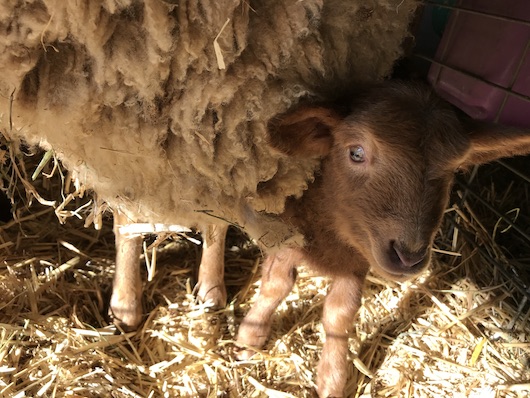
It is lambing season at Full Belly! About 25 lambs have been born and we expect that there will be over 100 by the time we are done. The weather has been beautiful and so far all has gone smoothly. The photos show the pregnant moms and some of the lambs that were born in the last week.
Understanding the mysterious powers of soil is a fascination shared by many farmers. Activities in the soil are hidden away and under-appreciated. Carbon, nitrogen and phosphorus, for example go through transformations in the soil that are critical to plant and human nutrition. Organisms in the soil can extract nitrogen from the atmosphere, break down wastes and poisons, or sequester carbon thus mitigating climate change. Soils with good structure and high organic matter can help to mitigate floods OR droughts, making healthy soil a high priority to all of us in California. The ways that soil organisms interact with plant roots to keep plants healthy is a process so choreographed and amazing that it is hard for scientists to unravel.
Poor farming practices can degrade soils to the point that they no longer absorb water or hold together in a rain storm. The role that farming plays in caring for soils can be illustrated with a negative example — The Dust Bowl in the 1930’s resulted from a severe drought, the effects of which were magnified by poor land management. The Soil Conservation Service was established in 1935, in part as a response to the soil health crisis. But soil is still one of our least recognized resources, even though it is a pillar of the Earth’s capacity to support human life.
Organic farmers often say that they strive to feed the soil more than to feed their crops. The legal definition of organic agriculture reflects this in emphasizing promotion of “biodiversity, biological cycles and soil biological activity.” (National Organic Program, 1995). I am a member of California’s Science Advisory Panel which provides advice to the Department of Food and Agriculture’s environmental programs. One of these, the Healthy Soils program, encourages the use of cover crops, composting, hedgerows, conservation tillage, and other soil-healthy practices. A critical component of the discussion hinges on climate change. Soils store more than half of the earth’s terrestrial carbon. Climate change threatens to increase soil temperatures which would accelerate the decomposition of soil organic matter, resulting in more CO2 in the atmosphere. Conversely, many of us see the soil as a potential carbon sink, if only we can use science, on-the-ground experiment, and public programs to harness that potential.
This little ode to soil was instigated, in part by the debate raging in the organic community about the proliferation of “organic” hydroponic operations that grow plants in anything but soil, relying instead on a myriad of inputs for crop nutrition. Simplifying the system is always the goal of those seeking profit and efficiency above all else, but calling hydroponic systems “organic” is a stretch.
Here at Full Belly, we continue to host tours and research delving into the mysteries and complexities of soil. We continue to grow cover crops on our land every year, trusting in the accumulation of stewardship to keep the soils healthy. We continue to experiment with reduced tillage as a way to protect the soils and sequester carbon. We hope that the soils on our farm, managed for decades using organic practices, will serve communities living here for decades to come.
Thank you for entrusting us to care for your soils! Many blessings on your meals.
—Judith Redmond

Above a new baby a little shy to wander too far from Mom.
Below Moms patiently awaiting their new arrivals.

